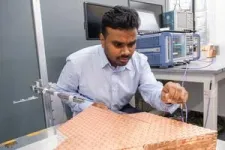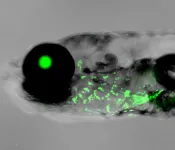(Press-News.org) Researchers led by Nanyang Technological University, Singapore (NTU Singapore) have developed a breakthrough technique that could lay the foundations for detecting the universe’s “dark matter” and bring scientists closer than before to uncovering the secrets of the cosmos.
The things we can see on Earth and in space – visible matter like rocks and stars – make up only a small portion of the universe, as scientists believe that 85 per cent of matter in the cosmos comprises invisible dark matter. This mysterious substance is said to be the invisible glue holding galaxies together. Finding it could help us understand cosmic phenomena that cannot be explained solely by the matter we see.
But proving the existence of dark matter is a herculean task. As its name suggests, dark matter is “dark”, meaning it does not normally emit or reflect light, carries no electric charge and interacts extremely weakly with normal matter, making it undetectable with conventional scientific instruments.
Dark matter is likely made up of particles and among the hypothetical particles proposed for it, a leading candidate is the axion.
Scientists have spent four decades looking for axions. One approach seeks to prove through experiments that existing particles in nature, like electrons or light particles, can behave like theoretical axions. If scientists can observe such behaviour, it increases the likelihood that axions might be real. The findings can then serve as a springboard to develop a method for detecting actual axions.
Despite coming close, the results from the search for axions remain inconclusive. But scientists led by NTU Singapore have now confirmed that naturally existing particles can indeed act like axions.
The researchers’ experiments showed that when light particles, also called photons, travel inside special crystal structures that they designed, the photons move like theoretical axions.
“The findings from our new crystal structures give us more confidence that we could one day use the crystals to detect real axions,” said Professor Zhang Baile from NTU’s School of Physical and Mathematical Sciences (SPMS), who led the researchers. “And since axions are promising candidates for dark matter, our research might lay the groundwork for unravelling some of the universe’s greatest mysteries.”
The study, reported in the scientific journal Science today (10 January 2025), could also lead to the development of more robust ways to transmit data for communications and more accurate quantum computers, he added.
Besides NTU, the research team comprised scientists from Canada’s Université de Sherbrooke; Germany’s Max Planck Institute for Chemical Physics of Solids; Switzerland’s ETH Zurich; Spain’s Donostia International Physics Center, the University of the Basque Country and Ikerbasque, the Basque Foundation for Science; as well as China’s Dongguan University of Technology, Nanjing University, Southern University of Science and Technology, University of Electronic Science and Technology of China, and Westlake University.
Illuminating the darkness
The term dark matter, coined in the 1930s, refers to the invisible glue hypothesised to prevent spinning galaxies from breaking apart, as there is not enough visible matter to account for the gravitational forces holding them together. So, dark matter could be the backbone undergirding the universe, which explains how galaxies form and evolve.
The axion is the current leading theoretical particle postulated to form dark matter. Its history can be traced to physicists Roberto Peccei and Helen Quinn, who, in 1977, proposed a concept to solve a particle-physics puzzle. Later, in 1978, physicists Frank Wilczek and Steven Weinberg independently realised the concept suggested that a new particle existed. Wilczek dubbed this particle the axion, after a laundry detergent brand, as it “cleaned up” a theoretical mess in physics.
Axions are believed to have originated from the sudden expansion of the universe after it was created in a cosmic event called the Big Bang. If axions are the main components of dark matter, they would be very hard to detect.
Even so, theory predicts that real axions can convert into photons in a powerful 10 Tesla magnetic field, which is 10 times stronger than the industrial electromagnet used to lift cars in scrapyards.
When axions convert into photons, the light particles can be detected using traditional equipment to show that axions exist. However, the conversion is expected to be highly inefficient, so the signals from converted photons would be weak and easily masked by other signals. So far, attempts to measure the signals of converted photons have not succeeded.
Scientists have also been trying another approach to finding axions: showing that naturally existing particles like electrons and photons can mimic axion behaviour and then use the information to develop a method to detect actual axions.
Researchers have traditionally focused on trying to prove that electrons can act like axions. But past studies have only shown electrons moving like axions in two dimensions – such as travelling horizontally and vertically – which is not good enough since axions move and exist in three dimensions.
NTU’s Prof Zhang led his team to address this issue by turning to photons. Earlier, his team worked on layered crystal structures with magnetic properties that can change how light particles travel and behave in them. The scientists had tried to use these crystals to simulate exotic particles that are hard to find in nature. But in the process, the scientists realised that they might have found traces of the elusive axions.
Looking also at past theoretical work that links axions to magnetic fields oriented in opposite directions, the researchers hypothesised that photons within the crystal could exhibit axion-like behaviour if a crystal’s layers had alternating magnetic properties.
The hypothesis was confirmed through experiments conducted by Prof Zhang’s team in collaboration with Prof Chong Yidong, also from SPMS, and other scientists.
In their study, the researchers used carefully designed crystalline geometric structures made of an artificial garnet crystal called yttrium iron garnet. This material has unique magnetic and optical properties and is used in microwave devices within radar and telecommunication systems.
In their experiments, the team observed that photons travelled in a single direction on the three-dimensional edges of the crystal’s structure – such as moving horizontally, vertically and sideways – without issues like scattering backwards. This behaviour of the photons in the crystal is also what theory predicts for axions.
To find real axions in the future, scientists could attempt to optimise the crystal designs further and use them in experiments to detect photons converted from axions under extreme conditions, such as strong magnetic fields. However, achieving this would require significant effort and resources. The team believes that their crystal structures might be able to boost the weak signals of axion-converted photons, but more research is needed to confirm this.
Besides paving the way to better understand the cosmos’ inner workings, the study’s findings could help make data transmission and quantum computing using photons more robust.
This improvement might be possible because the study showed that the researchers’ specially designed crystals can guide photons along the edges of the crystals in one direction without changing the direction they are travelling in. This property is critical for robust data transfer.
And even if there are imperfections in the crystal, the study found that the photons are unaffected as they do not change their travelling direction. This could open possibilities for less error-prone quantum computing.
Professor Yannis Semertzidis, from the Korea Advanced Institute of Science and Technology in South Korea and who was not involved in the NTU-led study, said that axions are an ideal, leading candidate for dark matter and likely contribute to a significant portion of it.
Prof Semertzidis, who researches on axions, said that the NTU-led study is a major breakthrough, and that the crystal structures used in the study set the stage for a “promising alternative” to existing methods for finding axions. He noted that the crystal structures have internal magnetic fields that “are perfectly suited for axion detection”.
“These crystal structures are expected to become a practical tool for searching axion dark matter in the near future,” added Prof Semertzidis.
END
NTU Singapore-led discovery poised to help detect dark matter and pave the way to unravel the universe’s secrets
2025-01-09
ELSE PRESS RELEASES FROM THIS DATE:
Researchers use lab data to rewrite equation for deformation, flow of watery glacier ice
2025-01-09
AMES, Iowa – Neal Iverson started with two lessons in ice physics when asked to describe a research paper about glacier ice flow that has just been published by the journal Science.
First, said the distinguished professor emeritus of Iowa State University’s Department of the Earth, Atmosphere, and Climate, there are different types of ice within glaciers. Parts of glaciers are at their pressure-melting temperature and are soft and watery.
That temperate ice is like an ice cube left on a kitchen counter, with meltwater ...
Did prehistoric kangaroos run out of food?
2025-01-09
Prehistoric kangaroos in southern Australia had a more general diet than previously assumed, giving rise to new ideas about their survival and resilience to climate change, and the final extinction of the megafauna, a new study has found.
The new research, a collaboration between palaeontologists from Flinders University and the Museum and Art Gallery of the Northern Territory (MAGNT), used advanced dental analysis techniques to study microscopic wear patterns on fossilised kangaroo teeth.
The findings, published in Science, suggest that many species of kangaroos were generalists, able to adapt to diverse diets in response to environmental changes.
More ...
HKU Engineering Professor Kaibin Huang named Fellow of the US National Academy of Inventors
2025-01-09
The US National Academy of Inventors (NAI) announced the 2024 Class of Fellows on December 10, 2024. Professor Kaibin Huang of the Department of Electrical and Electronic Engineering (EEE), Faculty of Engineering, the University of Hong Kong (HKU), was elected a 2024 Fellow in recognition of his inventions and contributions in tackling real-world issues.
Election to NAI Fellow status is the highest professional distinction accorded to academic inventors who have demonstrated a prolific spirit of innovation in creating or facilitating outstanding inventions that have made a tangible impact on ...
HKU Faculty of Arts Professor Charles Schencking elected as Corresponding Fellow of the Australian Academy of Humanities
2025-01-09
Professor Charles Schencking, Professor of History of the Faculty of Arts at the University of Hong Kong (HKU), has been elected as a Corresponding Fellow of the Australian Academy of Humanities (the Academy).
The Australian Academy of the Humanities was established in 1969 by Royal Charter to advance knowledge of, and the pursuit of excellence in, the Humanities. It is an independent, not-for-profit organisation with a Fellowship of over 730 distinguished humanities researchers, leaders, and practitioners ...
Rise in post-birth blood pressure in Asian, Black, and Hispanic women linked to microaggressions
2025-01-09
A study of more than 400 Asian, Black and Hispanic women who had recently given birth found that racism through microaggressions may be linked to higher blood pressure during the period after their baby was born, according to a new study by Columbia University Mailman School of Public Health. More than one-third of the mothers reported experiencing at least one microaggression related to being a woman of color during or after their pregnancy. The research conducted with colleagues at the University of Pennsylvania ...
Weight changes and heart failure risk after breast cancer development
2025-01-09
About The Study: In this nationwide cohort study in the Republic of Korea, postdiagnosis weight gain was associated with an increased risk of heart failure after breast cancer development, with risk escalating alongside greater weight gain. The findings underscore the importance of effective weight intervention in the oncological care of patients with breast cancer, particularly within the first few years after diagnosis, to protect cardiovascular health.
Corresponding Author: To contact the corresponding author, Dong Wook Shin, MD, DrPH, MBA, email dwshin@skku.edu.
To access the embargoed study: Visit our For The Media website at this ...
Changes in patient care experience after private equity acquisition of US hospitals
2025-01-09
About The Study: This study found that patient care experience worsened after private equity acquisition of hospitals. These findings raise concern about the implications of private equity acquisitions on patient care experience at U.S. hospitals.
Corresponding Author: To contact the corresponding author, Rishi K. Wadhera, MD, MPP, MPhil, email rwadhera@bidmc.harvard.edu.
To access the embargoed study: Visit our For The Media website at this link https://media.jamanetwork.com/
(doi:10.1001/jama.2024.23450)
Editor’s Note: Please see the article for additional information, including other authors, author contributions and affiliations, ...
COVID-19 vaccine hesitancy among Black women in the US
2025-01-09
About The Study: The results of this study suggest that addressing COVID-19 vaccine hesitancy among Black women requires a multifaceted approach that acknowledges historical traumas, provides clear and transparent safety information, and avoids coercive vaccine promotion strategies. These findings emphasize the need for health care practitioners and public health officials to prioritize trust-building, engage community leaders, and tailor interventions to address the unique concerns of Black women to improve vaccine confidence and uptake.
Corresponding Author: To contact the corresponding author, Brittany C. Slatton, PhD, email brittany.slatton@tsu.edu.
To access the ...
An earful of gill: USC Stem Cell study points to the evolutionary origin of the mammalian outer ear
2025-01-09
The outer ear is unique to mammals, but its evolutionary origin has remained a mystery. According to a new study published in Nature from the USC Stem Cell lab of Gage Crump, this intricate coil of cartilage has a surprisingly ancient origin in the gills of fishes and marine invertebrates.
“When we started the project, the evolutionary origin of the outer ear was a complete black box,” said corresponding author Crump, professor of stem cell biology and regenerative medicine at the Keck School of Medicine of USC. “We had been studying the development and regeneration of the jawbones of fishes, and an inspiration for us was Stephen ...
A Sustainable Development Goal for space?
2025-01-09
Scientists have called for the designation of a new United Nations Sustainable Development Goal (SDG) with the aim to conserve and sustainably use Earth's orbit, and prevent the accumulation of space junk.
There are currently 17 SDGs, adopted by UN members in 2015 as a universal call to action to end poverty, protect the planet for future generations, and ensure all people enjoy peace and prosperity.
But with growing numbers of satellites and other objects now orbiting our planet, there is growing concern that without some form of global consensus ...






